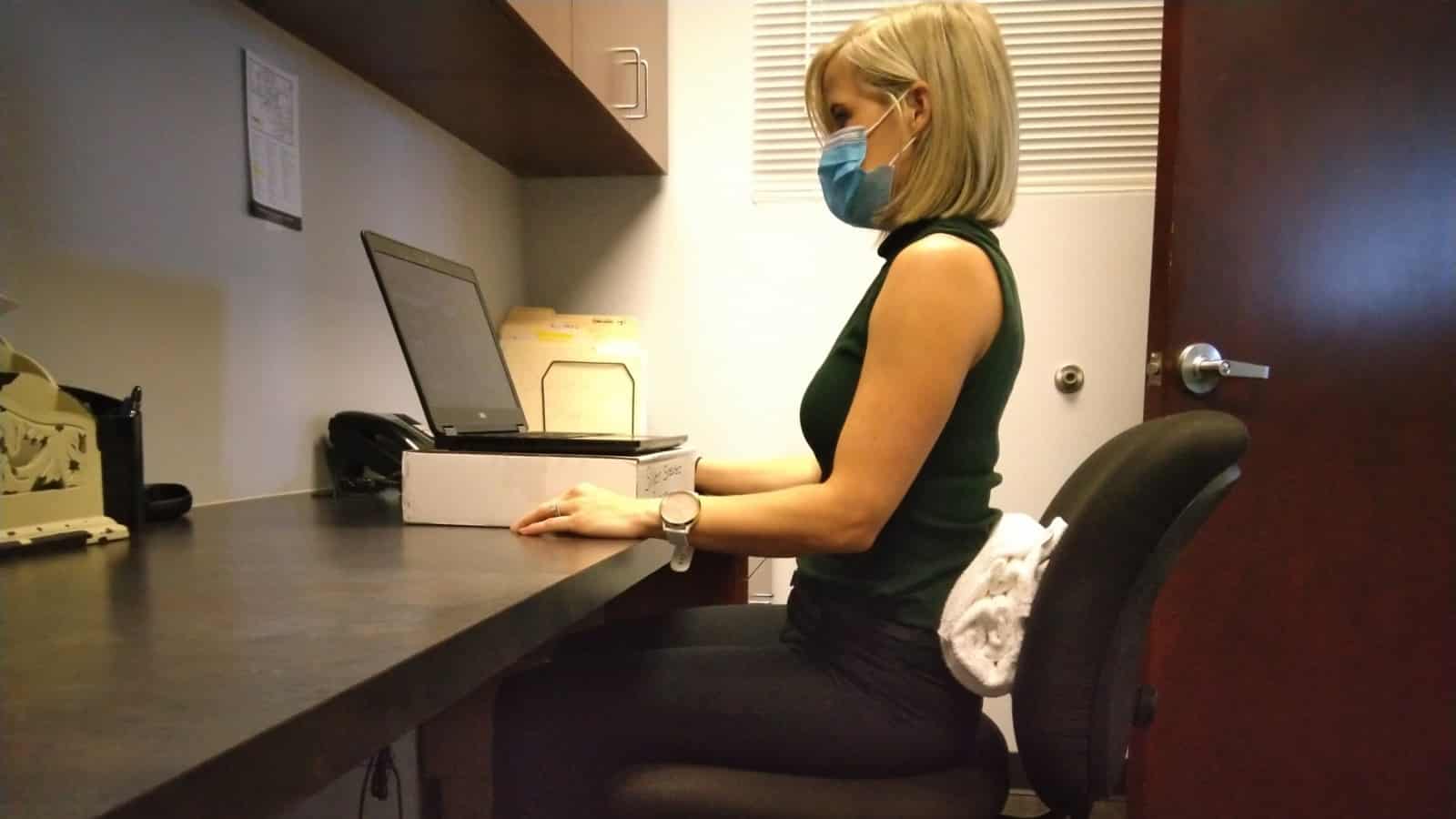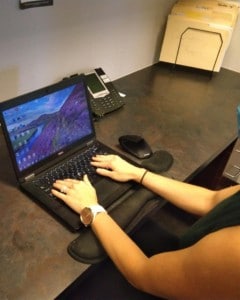Do you experience pain or discomfort after prolonged periods of sitting? Many Americans find themselves sitting for a great part of the day at school, work and even for electronic play. Optimal posture plays an integral role in maintaining overall health. Have you every thought about the impact sitting has on your daily life? Proper sitting posture is a simple but effective tool to help in relieving the aches and pains related to muscle tension in the shoulders and neck, numbness and tingling in the extremities, and soreness or weakness along the back. While taking breaks throughout the day to stand, walk and move your body is recommended for maintaining optimal health, sometimes that’s just not possible as the demands of the daily grind restrict your ability to move. Spooner physical therapist Heather Gibson PT, DPT reviews the signs and symptoms of poor sitting posture, as well as strategies you can implement to help achieve and maintain optimal posture while sitting.
Cues For Identifying Poor Sitting Posture
- Slouched back androlled shoulders
- Leaning forward and feet are dangling
- Back is pushed too far forward and lacks support
- Perfect posture
Many of the daily aches and pains we experience can be attributed to poor posture and can lead to a variety of prolonged and severe orthopedic conditions. Our spines serve as a major support system within our bodies and for the fascial and neural connections which transverse throughout. Poor posture can result in nerve impingement and pain or discomfort being transmitted to other regions of the body. Conditions such as TMD (temporomandibular dysfunction), frequent headaches, rib dysfunction, hip pain, and even pelvic floor dysfunction can all result from poor posture over prolonged periods.
- Leaning to one side
- Curled up with imbalanced support
- Legs crossed and leaning to one side
- Perfect posture
Some less obvious impacts of poor posture include the effects on the respiratory and cardiovascular systems. Sitting forward with a flexed trunk and rounded shoulders can inhibit the rib cage’s ability to properly expand. This reduces overall lung capacity as the diaphragm’s ability to descend is limited. This causes strain on both your respiratory and cardiovascular systems due to restricted oxygen flow throughout the body. The result, poor pressure management in the thorax and increased strain to back and pelvic floor. Over time, this can increase the risk of pelvic organ prolapse, bowel or bladder voiding dysfunctions, pain, and incontinence.
Tips For Achieving Proper Sitting Posture
Now that we know the importance of good posture, what can we do to implement that in our daily routine? Below, Heather shares the keys to optimal sitting posture.
- Elbows and forearms should stay close to your body, not outstretched. Make sure your arms are supported, either on the arm rest of your chair or a wrist rest on your desk. Elbows should be relaxed at about a 90 degree bend and you should be able to use your mouse without reaching your elbow out much further than this resting zone.
- Wrists should rest neural and not bent back into extension while typing.
- Your thighs should be about parallel to the floor with both feet resting flat on the floor with equal weight distributed through the feet. If your feet don’t reach the floor use a stable footrest to give them a flat surface to rest.
- Your lower back should have contact with your chair and a slight curve to support the normal curvature of your lower back. You can place a pillow or McKenzie roll behind your back if you feel like you do not have enough support or contact.
- Monitor your breathing. Practice deep abdominal breathing to reinforce an upright posture. The rate should be slow with exhales taking longer than inhales.
There are many amazing desk options and accessories on the market that are designed help achieve optimal sitting (or standing) positions. Sit-to-stand desks are ideal for breaking up prolonged sitting demands. Throughout the day give yourself a regular “posture awareness check–in”. Tactile cues such as kinesiology tape placed over the postural muscles can serve as an effective and gentle reminder.
Read about standing posture in “Stand Proud and Walk Tall” on the Spooner blog!
How To Improve Poor Posture
Physical therapy can help address any discomfort you may be experiencing from prolonged sitting. Your physical therapist can provide both education and movement guidance to strengthen your core and achieve optimal posture. Working regularly with a physical therapist can also help to prevent development of chronic conditions and musculoskeletal dysfunctions. A physical therapist will also be able to assess your current posture and recommend specific strengthening exercises or movements to improve postural endurance and awareness, and will be able to offer guidance to improve your work station set-up.
To help improve your posture and reduce any pain or discomfort you may be experiencing, watch the video below and try implementing these movement activities a few times throughout the day.
-
-
- Chin tucks
- Upper trap
- Thoracic spine extension with a foam roller or towel and deep breathing
- Wall angels
- Pectoral stretch at a wall
- Scapular clocks
-
If you are currently experiencing symptoms or if your symptoms persist after implementing the movement activities suggested above, please schedule a complimentary movement assessment with a Spooner physical therapist. The Spooner team is equipped to relieve or reduce immediate symptoms, implement postural strengthening and movement activities, master your ergonomic set up, and experience less pain and fatigue while working!
Learn more about Spine Rehabilitation at Spooner Physical Therapy. Ready to schedule an appointment? Schedule an appointment or complimentary movement screen with a Spooner physical therapist at one of our locations throughout the valley.










